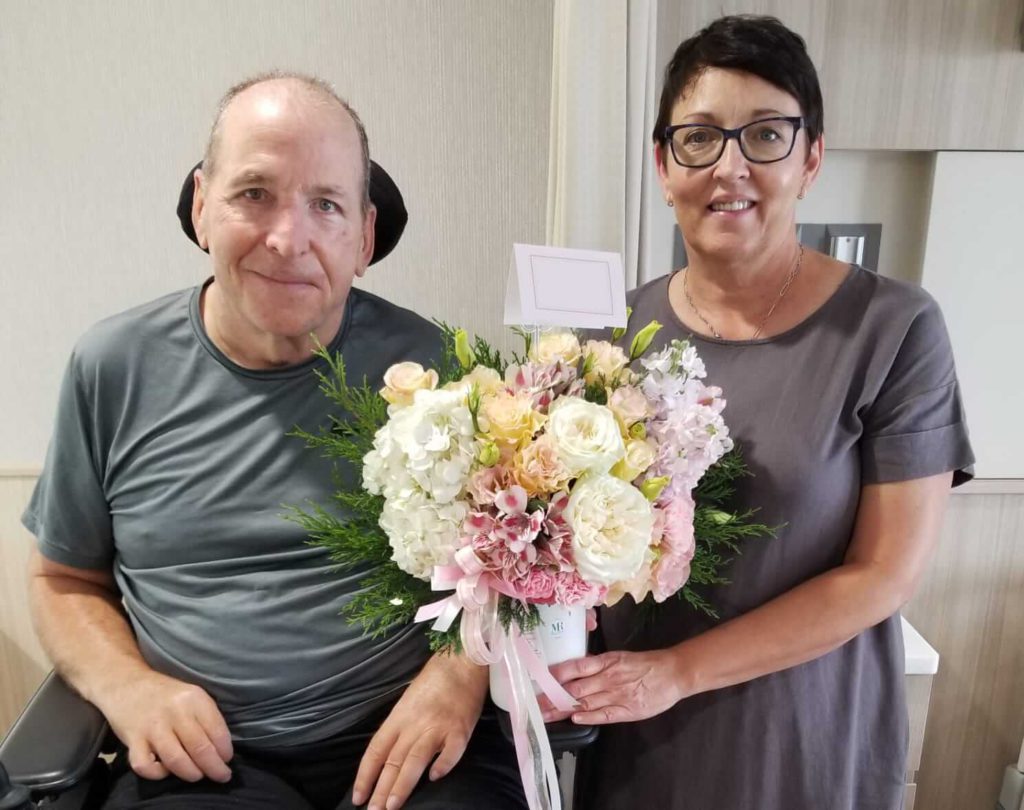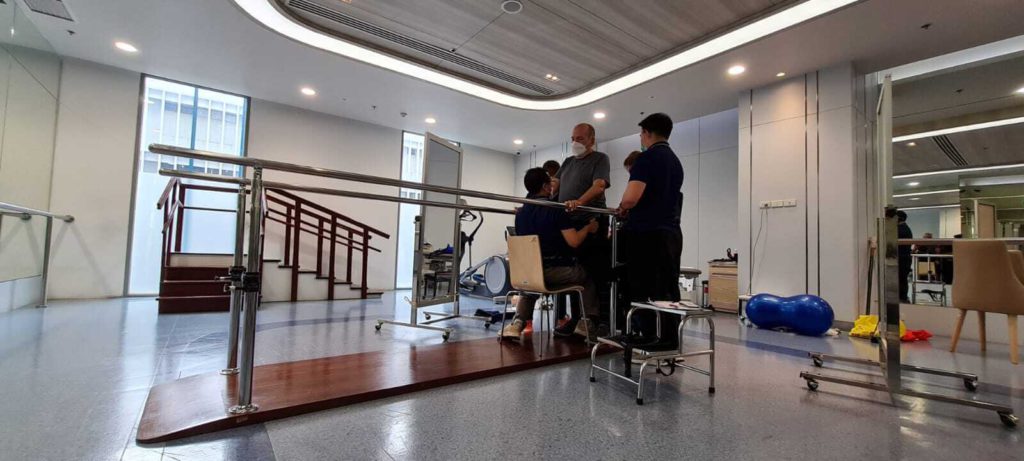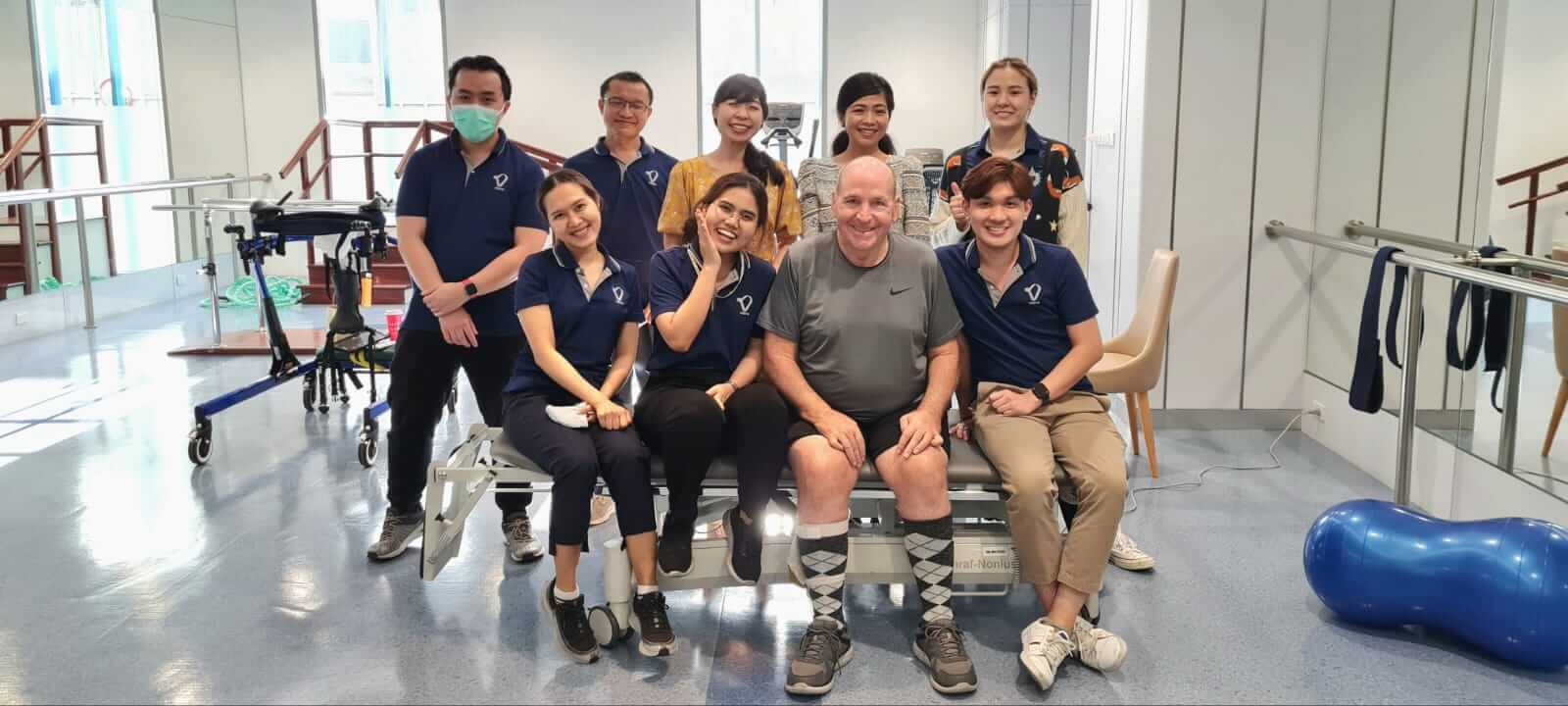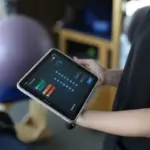Car accident spine injury is the most common type of spinal cord injury, with one study showing that 31.5% of all cases were the result of automobile crashes. Gordon is one of our patients, injured in a motor vehicle accident, who came to our Thailand site for epidural stimulation treatment. After reviewing his MRI, the medical team decided that he would benefit most from having two stimulators implanted, allowing support for both his upper and lower body function. He also received stem cell treatment, with up to 200 million mesenchymal stem cells, delivered in a combination of intravenous and optical injections. He was interviewed by Hanna Charles, our Director of Patient Representatives, and Dr. Nasir Majeed, our Medical Director, talking about his experiences.
Please could you introduce yourself?
My name is Gordon. I’m from Edmonton, Alberta, Canada. So I live in Western Canada, and I was 63 years old when I started my retirement. My wife and I were on a vacation in Southern California and I got into a car accident at that time. It resulted in a spinal cord injury and as things turned out, I got a C3-C4 injury at the time. I spent five months in hospital here in Canada before I was released and started my new life as a quadriplegic. It’s been just over three and a half years since I was discharged from hospital and we have tried virtually everything that we can that was accessible to us to enhance my recovery. My injury is incomplete. I was very healthy prior to the injury, I was active and I was strong and fit, so I got back into rehab and we’ve tried everything that was available to us to try and enhance the recovery that I got.

Could you tell us a little bit more about how your condition was over those three years?
Well, that’s an interesting question. When I got discharged, I had very low expectations as to what my recovery was going to be. The only movement that I had was in my big toe on my right foot. I could feel a slight sensation there. The only sensory that I had was from the nipple line upwards. I had neck movement but I could not move my arms or legs and as I said earlier, the only sensation I had was on that particular toe. During my rehab in the hospital, I got a little bit of movement back in my right leg and a very small amount in my right arm as well. But the prospects did not look good. I went to rehab outside of the hospital, worked hard there for two years, and got more function or more mobility back in my legs. And predominantly in my right side, in my right arm as well. I could do sit-to-stands for transfers. I could do a lot of things, better on my right side than the left and I was very hopeful for the future because of the recovery that I had at that point. But it seemed that I hit a wall, or a ceiling, that wouldn’t let me surpass that particular recovery. It didn’t matter what we did, how hard we worked, or how frequently we worked out, it didn’t seem to make a difference. So at that particular time, we really evaluated where we were at, and what our options were. Talking within our community is when we learned about you folks, and we started down that particular journey.
Could you share your thoughts about the facility and what your day-to-day looked like during your stay in Thailand?
I was very impressed with the hospital, the medical facility. It is virtually a new building or very close to being new and it’s very modern. It’s as good as you would find probably in North America. The staff there in the medical portion were very professional and they knew their jobs. We were very impressed with the quality of the food that we got and the items that were available on the menu. It was refreshing every day just to have a mixture of Thai food plus Western food. Our accommodations at the hospital were very good. My wife was able to stay with us in the same room. That’s important – that we’ve got a family member or a loved one there to be with us on the journey. The staff were very attentive to our needs and overall the experience was very good.
When you were heading over to Thailand, what expectations did you have in terms of the treatment results? What were your hopes and what did you think it was possible to achieve with the epidural stimulation?
Well, my primary goal was to get better motor skills or movement in my arms. I’ve got very limited movement, predominantly in my left arm – I’ve got a little bit more so in my right arm, enough that I can run a joystick for my power chair. My goal was to try and get my hand to my mouth. I didn’t know whether that would be possible or whether I could feed myself, scratch my nose if necessary, simple things like that. But I was wide open to any improvement that I could get from the experience. Because at my age, I’m running out of opportunities and I think my best efforts would be to try this and I was prepared to go wherever the journey would take me. If nothing else, we’re going to learn something. But I’ve noticed a great deal of change since I’ve had my surgery, in terms of a number of improvements. Predominantly, autonomic things have changed significantly for me and I was quite surprised at how quickly that had happened. I’m now getting more mobility in my right and left shoulders and also in my legs that I’ve never seen before. Things are changing on a daily basis.
What are the main improvements that you have seen so far?
One of the things that I noticed a couple of weeks after I started going to the gym and started mapping is my feet started to sweat and that had never happened to me before post-injury. In addition, I noticed that my back was sweating quite a bit as well. That was a substantial change for me. I’m also breathing better – I can take deeper breaths than I had been able to do before. It just came to me one day and it’s actually quite refreshing to be able to breathe deeper, talk longer and talk better than I did before. My blood pressure has increased somewhat and temperature regulation I think is coming into play. Sometimes before the lower extremities often times felt cold, like I didn’t have any sensation of temperature. Now I’ve got a nice warm feeling most of the time which is quite refreshing. In terms of describing some of my mobility improvements, around my trunk I’m able to hold myself more upright, move around a little bit more and we’re working on building more muscle in those areas so that I can support my trunk upwards and be stronger in a sitting position. Today for the first time, I was able to lift my knee towards my chest and put my foot on my foot rests on my chair, and that just came out of the blue and is a brand new discovery today. So now I’ve got a new exercise routine to continue working on that and building up strength on that so that I can do it on a regular basis. That was one of the big ones. Also, just recently, I noticed that I was now able to move my little toe, my toes on my left foot, that came two or three days ago. So it’s like Christmas in June. You just never know what you’re going to get from one day to the next.

Nine years is the average life expectancy of the epidural stimulation device. So throughout those years, we can still be hopeful for some new functions and new improvements to show as long as you dedicate enough time to your practice.
Well, I’m dedicated to doing that because as far as I’m concerned, that’s the only way that I’m going to be able to move beyond where I’m at today. We’ve made a substantial investment in terms of time and effort on everyone’s part. And I need to do my part in order to get the best outcome.
When you were in Thailand, we were working with you for around five hours a day. How easy or difficult was it for you to go through such an extensive physical therapy schedule and how do you manage your physical therapy now?
Initially, I found that it felt like a busy day because we were suffering somewhat from jetlag and being out of our own environment, but I knew I would have that issue for a couple of weeks until we got synchronized. Once you start getting into your routine, it’s good. As I said earlier, I’m 66 years old, I was reasonably fit given the parameters of my injury and I found that the daily routine was absolutely suitable. I like to be busy and I liked working with the staff that were there, trying to improve. The staff are friendly, nice and pleasant to work with and as long as I’m working towards our goal, I’m very pleased to be engaged.
Now, after leaving Thailand, we’ve got a gym that I go to that specializes in paralysis recovery. I have been going there for two and a half years prior to going to Thailand so we’re just getting back into the schedule there. Currently, I’m scheduled in two days a week. I’ve got an FPS cycle here at home and I’ve got some other equipment that I’ve worked with as well. So it’s my goal to work a couple hours a day at home on the days that I’m not going to the gym.
Now, after leaving Thailand, we’ve got a gym that I go to that specializes in paralysis recovery. I have been going there for two and a half years prior to going to Thailand so we’re just getting back into the schedule there. Currently, I’m scheduled in two days a week. I’ve got an FPS cycle here at home and I’ve got some other equipment that I’ve worked with as well. So it’s my goal to work a couple hours a day at home on the days that I’m not going to the gym.
Gordon, do you have any message you would like to convey to someone who is considering such a big step that is taking Epidural Stimulation surgery? If there is any message you would like to share we would really appreciate it.
Yeah, definitely. I would encourage anybody who wants to improve the quality of their life to pursue this and investigate it as a viable option, because as I mentioned earlier, I think this is a good solution. I’ve noticed a significant change, and everybody’s outcome will obviously be different but nonetheless, I think it is one of the leading solutions to improve people’s lives.
The above is not a verbatim transcript of Gordon’s interview and the exact wording and order of words has been edited to be read more easily. You can watch the full interview on our YouTube channel.





